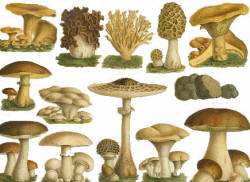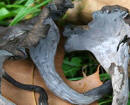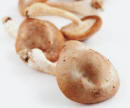Mushrooms

Mushrooms are not a vegetable, but the fruiting body of a fungi, starting
life as microscopic spores which so small that they are not visible to the naked eye.
It is believed that they have been in existence on earth for 90 million years,
and whilst many ancient cultures used and revered them, particularly for
medicinal purposes, it wasn�t until the 1650s
that they started to be cultivated in limestone caves on the outskirts of
Paris and it was to be 200 years later in 1891 that the first book on mushroom
growing would be published.
Â
Recent reports have shown
mushrooms to be a "superfood" and at only 13 calories in 100g/4oz
mushrooms, also easy on the waistline. Varieties are a good source of phosphorus,
magnesium, potassium and selenium, three essential B-vitamins: riboflavin,
niacin and pantothenic acid and are one of the few natural sources of vitamin D.
In addition, they contain virtually no fat or cholesterol and naturally low in
sodium and a good source of fibre. A 75g/3oz serving of portabella
mushroom caps provides more potassium than a banana. There are
Â
Today
mushrooms are eaten worldwide primarily as a culinary food ingredient with most
of us having forgotten their medicinal and nutritional value.
Mushrooms
have been used for medicinal purposes in oriental medicine for over 7,000 years
and the ancient Egyptians recognised their healing powers over 6,500 years ago.
They were also acknowledged in the writings of Hippocrates, he of Hippocratic
Oath fame, and the herbalists Pliny (Roman) , Dioscorides, and Galen (greek).
Some of
the current medicinal drugs derived from fungi include Statins which control cholesterol levels, Cyclosporin
which stops rejection
in transplant patients and, of course the 40's wonder-drug, penicillin.
Mushrooms
are the favourite of many chefs and cooks due to their versatility and variety.
They are suitable for all methods of cooking including microwaving and larger
specimens are excellent when stuffed with the filling of choice then baked.
Most mushrooms do not need to be peeled. Simply trim the stem end if necessary
and wipe clean.  They can then be cooked whole, cut in halves or
quarters, sliced thickly or thinly or chopped before cooking. Larger stems can
be separated from the caps before cooking by either twisting off or cutting.
There are
hundreds of recipes using mushrooms on this site. To find them all, use the
search facility at the bottom of this page. for general information about
preparing and cooking mushrooms see
How to
prepare and cook mushrooms.
Â
|


















